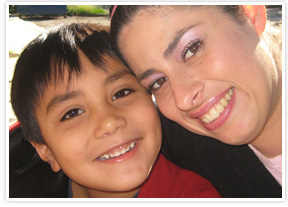We’ve been educating students with learning and behavior disabilities for nearly 40 years, and have served hundreds of families and over 30 San Diego area school districts. That’s a lot of questions and answers.
As unique as each student and family is, some questions get asked fairly often, at least often enough that we have compiled some of those that have been asked most frequently and have provided an answer. Just click on the question. You may want to know more. If so, please contact us.
What is a nonpublic school (NPS)?
What is a BCBA and how does it affect my child’s program?
Does ABA create rote responding?
A response is said to be “rote” when it requires no thinking, when it’s routine, or memorized, or when it does not depend on the context. An enormous amount of factual information is memorized, not dependent on context, and, therefore, essentially rote. For example, the responses to, “What is your name?” “What is this thing called?” “What is the capital of California?” “Who is the current U.S. President?” “When is Independence Day?” “What is four plus four?” and so on are essentially rote responses. They are memorized and they do not depend very much on the context. ABA provides teachers with methods to teach such facts efficiently and effectively, so students often learn lots of facts, and the rote responding that results is desirable.
A problem arises when the desired response depends on the context, including recent events, imminent events, the person to whom one is speaking, and what one has just said or done. Take, for instance, the common question, “How are you?” On most occasions, the response “fine” is acceptable, but there are many circumstances in which “fine” is not the desired response. Suppose that the child was sick or injured, or the child received an award at school, or the child did especially well at school and was about to receive a special treat at home, or the child’s father just returned from a six-month Navy tour of duty, or the child was about to go to Disneyland. Under these and many more conditions, the child’s response “fine” is just not a desirable response. It suggests that the child’s responding is rote, depending only on the specific question and not on any of the circumstances that typically would lead to a different, and more desirable response.
Any method, including ABA methods, which could teach the child rote responses could have taught the child to say “fine” when asked “how are you.” But, there are other considerations. If the child is very limited in what s/he can say, it may be that “fine” is all we can expect at this stage of learning, and we will need to teach the child to say many more things. It may be that the child is not very sensitive to the circumstances that would lead to a modified response, in which case we will need to teach the child to be more sensitive to such conditions, particularly the most significant ones like injury, dad’s coming home, and so on. It may be that the child is not very sensitive to the questioner, in which case we will need to teach the child to be more sensitive to the questioner’s needs and wants. Accomplishing these goals for students with autism is very challenging and ABA provides us with the methods to accomplish them.
Does ABA create “robotic” children?
To the extent that the term “robotic” merely refers to the undesirable version of rote-like responding that children with autism can display, the explanation above reveals that any teaching method can encourage it and, if used properly, ABA methods can overcome it. However, it seems that something more is meant when a child’s responses are called “robotic.” It’s not only what the child says but it’s also how the child says it. There is likely to be some feature of the child’s speech that resembles the voice production of a computer. Perhaps it’s that the voice is too loud, or it’s unmodulated, or it’s nasal, or the child speaks in a kind of staccato. It might also be that the child does not look at you when speaking or the child makes facial grimaces or emits other unusual behaviors. The extent to which the child’s verbalizations and other behaviors appear unusual encourages people to assume that the child cannot know very much. As a result, the explanation for the child’s display of knowledge, especially sophisticated knowledge, is that the child is a “robot,” which, of course, could not be further from the truth.
Behaving “naturally” in social interactions is very challenging for children with autism and it is also very challenging to teach. It is much easier to teach the child to say sophisticated things than it is to teach a more natural way of saying them. At Children’s Workshop, we place great emphasis on normalizing the way in which our students respond so that they not only display the knowledge they have acquired but they do so in a “natural” manner. ABA methods are especially suited to accomplishing these goals.
What Related Services are offered at Children’s Workshop?
What is your model for delivery of Related Services?
How do you monitor student progress?
What protocols do you have in place for parent communication?
Do you provide “sensory diets” and sensory integration therapy?



